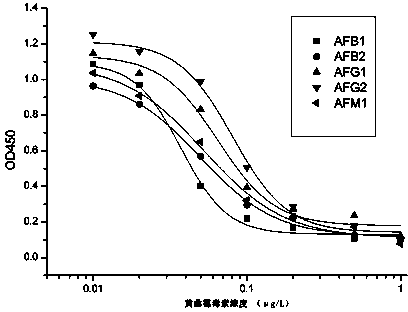Anti-aflatoxin general type monoclonal antibody hybridoma cell line and application thereof
A hybridoma cell line, aflatoxin technology, applied in antifungal/algae/lichen immunoglobulin, biochemical equipment and methods, instruments, etc. problem, to achieve the effect of good detection sensitivity and affinity
- Summary
- Abstract
- Description
- Claims
- Application Information
AI Technical Summary
Benefits of technology
Problems solved by technology
Method used
Image
Examples
Embodiment 1
[0021] Example 1: Preparation of hybridoma cell line 1G6
[0022] 1. Synthesis of complete antigen
[0023] Dissolve 1 mg of AFB1 (or AFM1) in 2 mL of methanol-water-pyridine (4:1:1, V / V / V), add 4 mg of carboxymethylhydroxylamine hydrochloride, and reflux at 85°C for 3 h , placed at room temperature for 16-24 h. Rotary evaporation, remove the organic solvent, add 1mL DMF to dissolve, then add 0.45 mg EDC and 0.3 mg NHS, mix well in the dark, stir at room temperature for 4 h; take another 5 mg KLH dissolved in 1 mL, 0.1 M, pH 8.0 in PBS solution; slowly add the above-mentioned activated aflatoxin solution dropwise into the KLH solution, stir and react at room temperature overnight, dialyze at 4°C for three days, and store in separate packages at -20°C.
[0024] 2. Animal immunity
[0025] Healthy BALB / c mice aged 6-8 weeks were selected for immunization. Take aflatoxin complete antigen (1 mg / mL) and the same amount of QuickAntibody immune adjuvant TM After mixing evenly, i...
PUM
 Login to View More
Login to View More Abstract
Description
Claims
Application Information
 Login to View More
Login to View More - R&D
- Intellectual Property
- Life Sciences
- Materials
- Tech Scout
- Unparalleled Data Quality
- Higher Quality Content
- 60% Fewer Hallucinations
Browse by: Latest US Patents, China's latest patents, Technical Efficacy Thesaurus, Application Domain, Technology Topic, Popular Technical Reports.
© 2025 PatSnap. All rights reserved.Legal|Privacy policy|Modern Slavery Act Transparency Statement|Sitemap|About US| Contact US: help@patsnap.com


